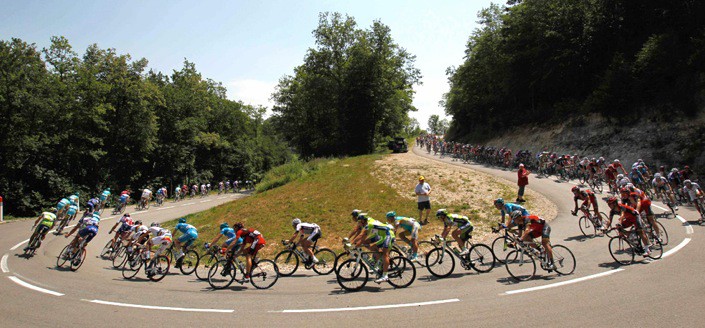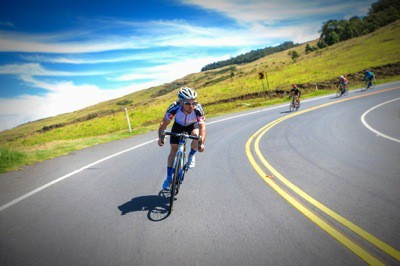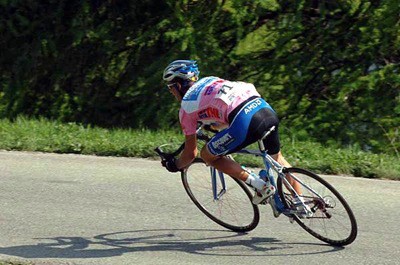
Why ride up the hill, when you can't enjoy the ride down? Thousands of people worldwide suffer from a fear of descending, but there is a cure! There's a better way to learn than to just remove your brake pads, so grab your bike and find a hill - it's time to head down!
Any descent will involve getting through some corners, so we have included that part too. Between the corners generally involves controlling your speed and lining yourself up for the next corner. It sounds overwhelming, but soon it will become your favorite part... Let's just pretend we're riding down a descent - try imagining yourself riding, as we talk you through our imaginary hill.
POSTURE
Assuming you're riding a road bike, try get down low on your bike, and if you're not comfortable with this then practice it elsewhere until you are. Lowering your body height will also lower your centre of gravity, making you more stable when riding at speed. It's also easier to control the brakes, giving you more brake modulation. Try getting your back flat and your head slightly up, so you've got a good field of view ahead of yourself.
LINE CHOICE

Photo: Eric Wynn / firstoffthebike.com

Photo: Eric Wynn / firstoffthebike.com
Choosing your riding line is pretty important if you want to descend smoothly. You can ride any line down a hillside, but choosing the smoothest line is definitely faster, and even makes it easier for you to get down the hill. Aim for a wide entry into the corner, cutting the apex as you make your way through the bend, and finally exiting wide as you head for the next bend. Cornering in this fashion allows you to carry your speed, and to maximize your traction by cornering smoothly and not 'cutting in' too hard on the corner. Remember: Wide line in. Cut the Apex. Wide line out.
BRAKING
When it comes to controlling your speed, it all depends on your brakes and when you choose to use them. Next time you hit a downhill, try braking before you reach the corner. Once you enter the corner, you should be at a speed where you can completely release the brakes through the corner. This increases your traction, as a rotating wheel has more grip than a slowing wheel. As you approach your braking point, gently and consistently apply squeeze to your brake lever, until you feel the brakes have an effect. Gradually increase pressure to slow yourself enough, and when you're happy with your speed for the corner, release the brakes and follow that line! Wide in, cut apex, wide out.

HOT TIP: Apply brakes 50/50 at first. You can learn more about front and rear braking as your skills improve.
THE LEAN
As you enter the corner, it's best to be in the position we first mentioned. Low down on your handlebars, flat back and head up. As you reach the part of leaning into the corner, there are a few things to remember... Put your outside leg in the 6 o'clock position and push down on the pedal, as if trying to snap the pedal off. This technique ensures the inside pedal is high, well clear of the ground. This method also increases downward pressure on your tyres, resulting in more traction! Keep it secret though, not many people know this trick...
These are the main aspects to cornering, but when it comes to the road in between each corner it's more straight forward! If the road is straight, use the chance to line yourself up for the next corner - or maybe sneak in some pedal strokes once you get your confidence up. Remember to breathe and stay as relaxed as you can. This will ensure you can remain in control, both mentally and physically.
AND... ACTION
Here it is all together, in one smooth flowing descent... Refer back to the points as we go if you forget what to do.

- As you head down the hill, ensure you are in the correct posture.
- Keep your body low down, and keep your fingers touching the brake levers at all times. Keep your head up, and look where you want to go.
- As you approach your first corner, slowly move wide of the corner and begin to brake. As you apply brakes, ensure your speed is decreasing enough for the particular corner you're entering.
- Release the brakes as you begin to lean into the corner and push down on the outside pedal.
- Cut into the corner, and at the sharpest point of the bend (the apex) you should be right up against the centreline, or the road edge depending on which way the corner is turning.
- As you spot your exit to the corner, look where you want to go and allow your bike to drift wide as you exit the bend. This allows you to maintain speed and also get yourself ready for the next corner. Easy!
When it comes to your confidence while descending, always play it safe. If you're not confident in doing something, you're best to work your way up to it.
While descending, always remain in complete control of your speed. If your speed gets out of hand, you'll need to brake earlier and harder before a corner. If you aren't used to the excess speed, you'll misjudge your approach and potentially overshoot the corner or slide out.

HOT TIP: When the road is wet you'll have far less grip. Double your braking distance, halve your speed and remain in control.


